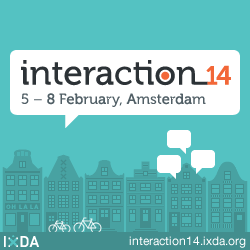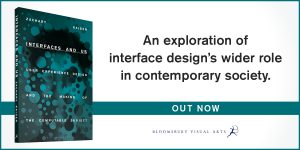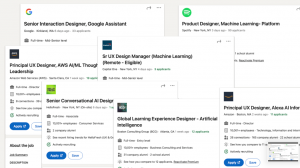Videos of Day 3 of Interaction14 conference

Is there a Language of Interaction Design [Not yet online]
Keynote by Gillian Crampton Smith, Designer/Educator, IUAV University of Venice
> Full description
Bridging the Physical-Digital Divide [44:32]
Jason Mesut, Head of User Experience at Plan Strategic
Bridging the gap between Industrial and Interaction Design to develop better products and services for the physical-digital age
influence on our world. In some ways, this is great, but we seem to have forgotten those designers with the talent for crafting physical forms that can fit into our hands, our homes and our lives.
For a future Internet of Things we need to better engage Industrial Designers in what we do. This talk will explore how we do that.
> Full description
You’re unique. Just like everybody else. Or how your perspective is limiting your work and hindering your team [32:08]
Tash Wong, Chief Coaster Officer of Coastermatic
We pride ourselves on being empathetic, but how does our intrinsic understanding of the world work to hinder us?
Individual perspectives can keep us from understanding others. Using gender as a lens, we can uncover fascinating differences in the ways we use language and storytelling to communicate, as well as distinctive modes of approaching technology.
In this talk, learn how understanding different modes of interacting with the world can provide us with a framework to uncover new ideas, better empathize with users, and build stronger relationships between teams at work.
> Full description
Education summit debrief [40:17]
Dave Malouf, Sr. Manager of Product Design at Rackspace
During the 2014 Interaction Design Education Summit, several educators, practitioners and students participated in an interactive dialogue on the future of interaction design education.
Introduced by Jared Spool, and coached by Gillian Crampton Smith, Daniel Rosenberg and Fred Beecher, scenarios were created and developed around the themes of alternative educational models; design schools versus industry; online presence and portfolios and (new) forms of apprenticeship.
> Full description
Typography at the intersection of Design, Technologies and Languages [37:18]
Peter Bil’ak, Typotheque
Type design is full of contradictions – it is one of the most specialised design disciplines, but also the one whose results audience cannot escape, being bombarded by type daily.
Peter Bilak discusses what thoughts go into designing a typeface — starting with language, technology and how it affects its design.
> Full description
Pair Design and Why You Need It [Not yet online]
Christopher Noessel, Managing Director at Cooper
> Full description
Making More UX Designers: UX Apprenticeship in the Real World [41:00]
Fred Beecher, User Experience Designer at The Nerdery
The demand for user experience designers has skyrocketed. Interest in UX as a career has soared along with that demand. Every UX designer gets asked how to get into the career, but the sad fact is that there’s no real answer to that question. Although demand is high, that demand is only for designers with 2-3 years of experience or more. There are simply not enough experienced designers to fill these positions, and this experience gap is a barrier to offering potential designers a consistent path from interest to employment.
> Full description
Design in motion: the new frontier of interaction [37:58]
Antonio De Pasquale, Senior Interaction Designer at frog
Technological advances have allowed, in the last few years, a big step forward in the dynamic behaviors and interactions patterns that we used to do with software in the past. Motion is one of the key element of this change but how can we imagine & sketch the way something feels & reacts? Starting from the basic of motion design, we discover a set of “standard” motion patterns and how we can sketch & use them in a design project to increase affordance, to simplify complex interactions and to give a new dynamic brand identity to our products.
> Full description
Jam session
A story a day keeps the doctor away [09:49]
Damjan Obal, UX Consultant & Chief Storyteller at Edgar
In July 2013 Damjan embarked on an epic journey to become a better storyteller. The motivation came when his team started working on their startup EdgarTells.me which he co-founded. Their goal is to encourage and help people craft and share their stories. On the other hand, the mission he set for himself was: share one story a day, mostly about and from new, random people he meets.
> Full descriptionThe Shock of the New: Communicating Change [08:32]
Stephanie Aaron, Senior Interaction Design Consultant at Large Financial Institution
You’ve just made something great, now don’t piss off your customers.
We’ve all had the experience – we open an essential site, or our favorite app and everything is different. It might actually be better but may not seem so in that moment as we’re trying to accomplish a task.
Learn how we can ease our customers into the new by preparing them for those changes through better communication methods.
> Full descriptionWhen Things Come Alive! [09:01]
Gaurav Patekar
This talk presents a novel and fun way of interactions we will have with devices of tomorrow.
Imagine, on one of these regular mornings, you go to your kitchen to make breakfast, and hear your toaster saying “GOOD MORNING” in a voice good enough to brighten up your day. What happens when inanimate objects start talking to us?
This talk presents an exploration into “devices with character”. How the character affects the interactions and behavior that they have with us, and how this can be leveraged to make devices more understandable and fun.
> Full description
Interaction béchamel [27:26]
Guillaume Berry
Eating is a primary human need and one of our own energy source. We have developed tools and techniques to hunt, grow, produce and keep all sorts of food. We have designed countless solutions to cook and present food, make it an interesting activity to renew.
Interaction design is like a problem solving cake with human emotions flavors in it. Let’s find out if we can call ourselves Design Chefs or at least be good interaction cooks for people.
> Full description
Designing for Dasein: what philosophy class taught you about design [37:56]
Thomas Wendt
This talk examines philosophical origins of design principles and develop new models of practical implementation.
The main goal of this presentation is to trace design principles and practices back to their philosophical roots in order to gain new insight on how they complement one another.
The talk covers how modern design can be traced back to phenomenology, a philosophical tradition that emphasized active engagement in the world, understanding ourselves through objects, and practical implications of theory. It includes a short history of phenomenology followed by illustrations of how modern designers practice “applied phenomenology” through technology design.
> Full description
User Interaction: Experienced vs Remembered [53:28]
Lucinio Santos, User Experience Engineer at IBM
Your memory of an experience may not match the experience itself as you lived it. What constitutes a positive or negative user experience (as measured by observation or usability evaluations, for example) does not necessarily translate to a corresponding positive or negative memory of that experience (as captured by surveys or other forms of retrospective assessment). This session describes selected research in Psychology and Behavioral Economics relevant to the differential factors affecting how individuals experience their interactions, vs how they remember them. It also discusses how those two facets of an experience are relevant to different aspects of a product’s lifecycle.
> Full description
The Visual [Emotional] Vocabulary of Sustainability [33:43]
Arlene Birt
Structuring messages to help audiences connect with sustainability: Opportunities at the intersection of information, communication, visualization and interaction.
Social and environmental sustainability are complex and daunting topics. Convincing people to adjust their behavior in order to adopt more sustainable patterns is a challenge. When the goal is to help audiences understand the deluge of data, communicating context is highly important. This has a lot to do with establishing an emotional connection between individuals and information.
Data that is designed to tell a story can create a strong connection between high-level, abstract sustainability concepts and the daily, individual actions of consumers.
> Full description
Stop Fighting, Start Designing [33:01]
Dan Brown, co-founder EightShapes
In this session, Dan Brown talks about some basic techniques for dealing with conflict. As a participant, you will discuss ways for dealing with three common situations (perhaps you’ve faced them):
– Excluded from planning: Designers don’t get to participate in planning the project, and find themselves stuck with unreasonable milestones.
– Inconsistent expectations: Project participants and decision-makers change their tune from one meeting to the next.
– Lack of a decision-maker: The project doesn’t have a single point of contact for making decisions, causing the team to spin out when a final call is required.
> Full description
The Computer as Extended Phenotype [32:43]
Steven Pemberton, senior researcher at CWI
The “phenotype” in genetics is any characteristic of an organism like form, development, behaviour, even products of behaviour like birds’ nests. An unusual property of humans is language, where survival information can be passed by other means than genes.
This leads to “memes”, analogous to genes, as carriers of information. Memes have allowed humans to create buildings, cities, and fly like gods through the sky, though in cramped surroundings with terrible food. And to create computers.
So are computers part of our phenotype? Should we care?
> Full description
Choice…Gateway to Engagement [30:14]
Brad Nunnally, User Experience Solution Architect at Perficient XD
Understanding the anatomy of a choice is crucial to surviving the new world of product design. If designers, developers and product owners can better understand how choices are made and, more importantly, why they get made, they will be better equipped to disrupt the market. This talk explores the complexity of making choices and how an environment built for choice leads to a better customer experience.
> Full description
Interacting in the Global City [36:18]
Keynote by Saskia Sassen, Professor of Sociology, Columbia University
In today’s global cities, public urban space is constituted in my different ways. Residents in the same neighborhood may have very diverse types of knowledge about their shared public space: The children know the neighborhood at ground level, the tech designer knows the Wi-Fi coverage at the cafes, the homeless know about the night fauna. How do these understandings of urban space affect our view, use, and design of technology?
> Full description



